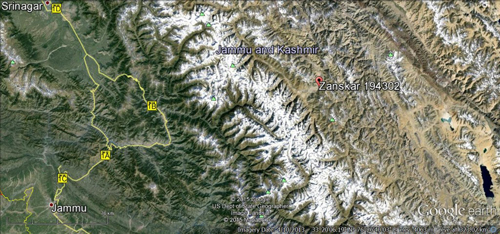Water from an artificial lake that had been created by a river blockade following a massive landslide on Phutkal river in Zanskar area of Ladakh in north-west India, has drained out almost entirely in the form of a flash flood, officials said. No loss of life has been reported from anywhere in the region, they added.
The Kargil district administration claimed May 7 flash flood had ended the threat caused by the artificial lake. As reported first by thethirdpole.net, the lake had been formed when a massive landslide blocked the river on January 15.
See Huge landslide blocks river, threatens Ladakh
Speaking to thethirdpole.net, Ghulam Hassan Khan, deputy commissioner of Kargil district, said that the breach in the landslide debris, which had been created through controlled blasting some weeks back, became wider on the morning of May 7 and caused a flood downstream. It led to minor damage, he added.
“As soon as we got an alert from our men at the site, we issued a flood alert and asked people who were likely to get affected to move to higher locations,” Khan told thethirdpole.net.
According to the deputy commissioner, around 4,000 people, who had shifted to higher locations, returned to their homes by May 7 evening as the water flow in the river went back to normal.
He said that the artificial lake had been around 30 feet deep, but “More than 70% of the water has drained out from the lake and now there is just around five feet of water in it.”

According to Khan, he and the superintendent of Kargil police took stock of the situation by helicopter on May 7. “Our aerial survey revealed that the damage was not that much. Only a few structures including some foot-bridges, a school building and four houses in Shum village have got damaged,” Khan said. “No loss of life has been reported from anywhere in the region.”
A few weeks back a team of experts from India’s National Disaster Management Authority (NDMA) had succeeded in creating a channel for releasing water from the huge artificial lake.
See Experts blast and dig channel to drain blocked Ladakh river
The aerial survey carried out after the landslide, following repeated appeals by the local member parliament and district administration, could not yield any reliable information about the disaster which was building up. The government of India finally sent experts from NDMA, who carried out a ground survey before starting the operation.
Using explosives in a controlled blasting operation, the experts finally conducted the digging operation with the support of Ladakh Scouts, an Infantry Regiment of the Indian army.
It took them around one week to dig the channel 100 metres long, two metres wide and two metres deep. The water kept draining out slowly, with authorities expecting the breach to gradually deepen and widen on its own.
“With the day temperature rising abruptly over the past few days, more water accumulated in the lake due to which the breach got wider and deeper causing a considerable volume of water to gush out abruptly in the form of a flood,” Khan said.
He added that no further flooding was expected unless there was any other blockade anywhere else along the course of river.
“As the breach has now got wider and deeper, it can’t hold a large amount of melt-water. And this rules out any further flooding because of this lake,” the deputy commissioner said.

